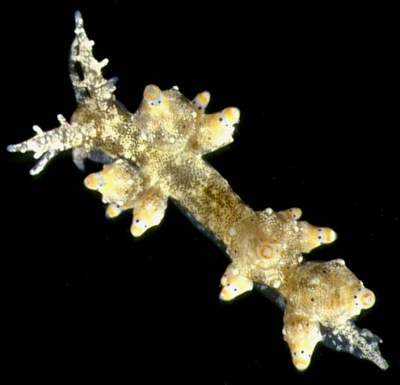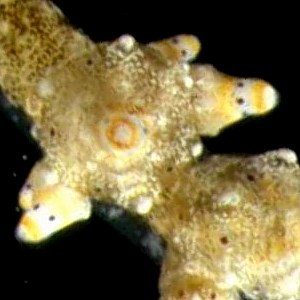

Eubranchus rubropunctatus
Edmunds, 1969
Order: NUDIBRANCHIA
Suborder: AEOLIDINA
Family: Eubranchidae
DISTRIBUTION
Possible wide Indo-West Pacific distribution
PHOTO
Heron Is., Great Barrier Reef, Queensland. 6-10mm long alive. Photo: Julie Marshall.
Described from one 4mm long animal from Tanzania, it is not possible to be sure which features of its colour pattern are variable. The body and appendages were described as:
'transparent greyish and the whole of the dorsal and lateral surfaces are covered in brownish-yellow spots and with white spots. ... The cerata are huge for the size of the animal and have two tiers of tubercles and a bulbous tip. The liver duct in the cerata is brown and narrow but swells just below the cnidosac region as in Eubranchus misakiensis. The tubercles are white and there is a band of white just below the cnidosac region. Distal to this is a band of gold, then a band of pale blue containing from four to six circular red spots, then another band of gold, and the tip of the cnidosac is clear.'
A similarly coloured species, without the red spots, is illustrated here on the Forum from Hong Kong as Eubranchus cf. rubropunctatus. Eubranchus rubropunctatus was described from one 4mm long juvenile. Julie Marshall's photo differs in two features. In the original description the rhinophores were described as having 'spaced small tubercles'. I assume that in Edmund's juvenile specimen the large prominent rhinophoral papillae in this photo of a larger animal were undeveloped. The second difference is that in the original specimen, the red spots on the cerata were in a band of blue, which can't be seen Julie's photos.
Note added 15 May 2009: See discussion [message #22443] as to whether this is a synonym of Eubranchus mandapamensis.
References:
• Edmunds, M. (1969) Opisthobranchiate Mollusca from Tanzania I. Eolidacea (Eubranchidae and Aeolidiidae). Proceedings of the Malacological Society of London, 38: 451-469.
• Marshall, J.G and Willan, R.C. 1999. Nudibranchs of Heron Island. Leiden, Backhuys Publishers. (Eubranchus rubropunctatus, pp. 138-139, 251).
Rudman, W.B., 2001 (July 13) Eubranchus rubropunctatus Edmunds, 1969. [In] Sea Slug Forum. Australian Museum, Sydney. Available from http://www.seaslugforum.net/find/eubrrubr
Related messages
Eubranchus rubropunctatus from Heron Island
September 26, 2001
From: Julie Marshall


Dear Bill,
Following your message about Eubranchus cf. rubropunctatus from Hong Kong I am attaching a picture of Eubranchus rubropunctatus from Heron Island. I have found eight specimens in all, ranging in size from 6 to 10 mm, and all have the red spots in the band below the cnidosac region. I have found that the red spots can vary in colour from red to dark purple to almost black. The Hong Kong specimens also seem to lack the tubercles on the rhinophores as described by Edmunds and which can be clearly seen in the Heron Island animal. Edmunds description was based on only one animal which was 4 mm. The larger specimens from Heron Island show the tubercles more strongly developed.
References:
• Edmunds, M. (1969) Opisthobranchiate Mollusca from Tanzania. I. Eolidacea (Eubranchidae and Aeolidiidae) Proceedings of the Malacological Society of London, 38: 451-469.
• Marshall, J.G and Willan, R.C. 1999. Nudibranchs of Heron Island. Leiden, Backhuys Publishers. (Eubranchus rubropunctatus, pp. 138-139, 251)
Julie Marshall
j.marshall@latrobe.edu.au
Marshall, J., 2001 (Sep 26) Eubranchus rubropunctatus from Heron Island. [Message in] Sea Slug Forum. Australian Museum, Sydney. Available from http://www.seaslugforum.net/find/4869Dear Julie,
Your animal certainly fits better than the Hong Kong one. It's unfortunate that quite a few aeolid species seem to be described from single juvenile specimens. In Malcolm Edmund's case he gave a description of the colour of the live animal, which is a great advance on the many species that have been described over the years from preserved decolourised animals. It is just unfortunate that colour and some body details change quite considerably as an animal grows, and often there is considerable colour variation within adults of a particular species. Describing species from a single specimen, adult or juvenile, can cause major problems.
Best wishes,
Bill Rudman.
